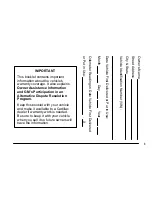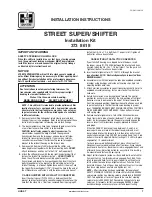
yellow
blue
4-30
The label shows the size of your original tires and the
inflation pressures needed to obtain the gross weight
capacity of your vehicle. This is called the Gross Vehicle
Weight Rating (GVWR). The GVWR includes the
weight of the vehicle, all occupants, fuel and cargo.
The Certification/Tire label also tells you the maximum
weights for the front and rear axles, called the Gross
Axle Weight Rating (GAWR). To find out the actual
loads on your front and rear axles, you need to go to a
weigh station and weigh your vehicle. Your dealer can
help you with this. Be sure to spread out your load
equally on both sides of the centerline.
Never exceed the GVWR for your vehicle or the GAWR
for either the front or rear axle.
CAUTION:
Do not load your vehicle any heavier than the
GVWR, or either the maximum front or rear
GAWR. If you do, parts on your vehicle can
break, and it can change the way your vehicle
handles. These could cause you to lose control
and crash. Also, overloading can shorten the life
of your vehicle.
NOTICE:
Your warranty does not cover parts or
components that fail because of overloading.
If you put things inside your vehicle
--
like suitcases,
tools, packages or anything else
--
they will go as fast as
the vehicle goes. If you have to stop or turn quickly, or
if there is a crash, they’ll keep going.
Summary of Contents for VENTURE 1999
Page 100: ...yellowblue 1 92 NOTES ...
Page 184: ...yellowblue 2 84 The Instrument Panel Your Information System ...
Page 276: ...yellowblue 4 40 NOTES ...
Page 310: ...yellowblue 5 34 NOTES ...
Page 414: ...yellowblue 7 38 Maintenance Record DATE ODOMETER READING SERVICED BY MAINTENANCE PERFORMED ...
Page 428: ...yellowblue 8 14 NOTES ...
















































